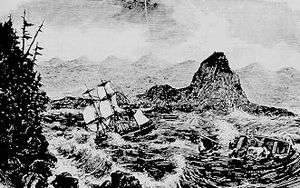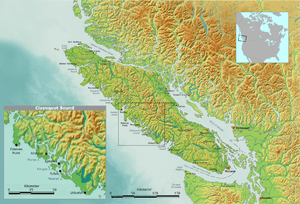Tonquin (1807)
 The Tonquin in 1811. | |
| History | |
|---|---|
| Owner: | John Jacob Astor |
| Operator: | Jonathan Thorn |
| Builder: | East River Ship Yard |
| Launched: | 1807 |
| Acquired: | 1810 |
| Fate: | Blown up June 1811 at Clayoquot Sound, Vancouver Island |
| Sunk: | 1811 |
| General characteristics | |
| Class and type: | bark |
| Displacement: | 269 or 290 tons |
| Length: | 96 ft (29 m) |
| Propulsion: | Sail, 3 masted |
| Armament: | 10 guns |
The Tonquin was a 290-ton merchant ship owned by the American Pacific Fur Company (PFC). The ship was intended to establish and supply PFC outposts in the Pacific Northwest along with participating in the Maritime Fur Trade by selling valuable furs to the Qing Empire. Work began in May 1811 on the sole trading post founded by the Tonquin, Fort Astoria. After the initial construction was completed, the ship sailed north to trade with the Nuu-chah-nulth nations of Vancouver Island. While the crew was negotiating commercial transactions with the Tla-o-qui-aht nation in June, a dispute arose due to Jonathan Thorn's treatment of an elder.[1] The entire crew besides its interpreter from the Quinault nation was killed by armed Tla-o-qui-aht led by chief Wickaninnish. The Tonquin was destroyed and sunk at Clayoquot Sound.
Early career
Built in New York City in 1807, the Tonquin was purchased by American John Jacob Astor on August 23, 1810.[2] This vessel was to be used in the fur trade of the Northwest coast of America.[3] Astor paid $37,860 to Fanning & Coles for the 290-ton bark to be used by the Pacific Fur Company, in which Astor owned a half-interest.[3] He gained the services of United States Navy lieutenant Jonathan Thorn and put him in command of the 10-gun merchant vessel.[3]
Voyage to Columbia River
On September 8, 1810 the Tonquin departed the New York harbor, bound for the Columbia River in the Pacific Northwest.[4] Cargo on board included fur trade goods, seeds, building material for a trading post, tools, and the frame of a schooner to be used in the coastal trade.[3] The crew consisted of 34 people including the captain, 30 of whom were British subjects.[5] Four partners of the company were on board: Duncan McDougall, David and Robert Stuart, and Alexander McKay.[3] Additionally there were 12 clerks and 13 Canadian voyageurs, plus four tradesmen: Augustus Roussel, a blacksmith; Johann Koaster, a carpenter; Job Aitkem, a boat builder; and George Bell, a cooper.[6]
After leaving the national waters of the United States the Tonquin sailed south east into the Atlantic. On the 5th of October, the ship came within sight of Boa Vista,[7] The enforced policy of Impressment by the United Kingdom of Great Britain and Ireland made Thorn wary of passing British vessels. Consequently he decided against staying at the holdings of the Kingdom of Portugal and avoided the Cape Verde Islands.[8] After sailing down the coast of West Africa, the Tonquin made way for South America. Off the coast of Argentina an extreme storm struck, ruining many of the sails and added two additional leaks in the hull.[9] As the voyage continued on the water supplies dwindled to three gills a day per sailing member.[10]
The vessel landed at the Falkland Islands on 4 December to make repairs and take on water supplies, with a suitable source of fresh water located at Port Egmont.[11] Captain Thorn set sail on the 11th of December without eight of the crew, including partner David Stuart, along with Gabriel Franchère and Alexander Ross.[12][13] Having only a rowboat, the eight men spent over six hours rowing before they caught up with the Tonquin.[12][13] The Tonquin stopped to pick up the stranded crew mates as Robert Stuart threatened Thorn that if he did not "You are a dead man this instant."[13] Thorn's actions lead to increasing tensions between him and the employees of the Pacific Fur Company. Communication between company workers was no longer held in English to keep the captain excluded from discussions. Company partners held talks in their ancestral Scottish Gaelic and hired PFC workers used Canadian French. The atmosphere of "their jokes and chanting their outlandish songs" greatly frustrated Thorn.[13] On December 25 the Tonquin rounded Cape Horn and sailed north into the Pacific Ocean.
Kingdom of Hawaii
The Tonquin reached the Kingdom of Hawaii on February 12, 1811, dropping anchor at Kealakekua Bay.[14] The possibility of men deserting the ship in favor of the islands became a major threat. Thorn had no choice but to make amends with the PFC partners to police the crew.[15] Several men abandoned ship but the cooperation of the nearby Native Hawaiians saw their return. One man was flogged, another put in chains. Thorn assembled all of the crew and PFC employees and harassed the men to remain on the ship.[15] Commercial transactions eventually with the Hawaiians; the crew purchased cabbage, sugar cane, purple yams, taro, coconuts watermelon, breadfruit, hogs, goats, two sheep,[16] and poultry for "glass beads, iron rings, needles, cotton cloth".[15][14] An courier from government agent John Young ordered the Tonquin visit him for meat supplies and then to have an audience with Kamehameha I who resided on Oʻahu.[17]
Upon entering Honolulu, the crew was greeted by Isaac Davis and Francisco de Paula Marín, the latter to act an interpreter in negotiations with Kamehameha I and prominent government official Kalanimoku.[18] Besides his work in discussion between the Hawaiian Monarch and the PFC officers, Marin also acted as the pilot to guide the ship into port, for which he received Five Spanish dollars for.[19] 24 Hawaiian kanakas were recruited for three years service, half in the fur venture and the other half as laborers on the Tonquin.[20] One of the Hawaiians, Naukane, was appointed by King Kamehameha I to oversee the interests of these laborers. Naukane was given the name John Coxe while on the Tonquin and later joined the North West Company.[21] The Tonquin and its crew left the Hawaiian Kingdom on 1 March 1811.[22]
Astoria
On 22 March 1811 the Tonquin reached the Columbia River but the dangerous Columbia Bar posed a major problem.[23] Thorn sent five men in a boat to attempt to locate the channel, but the rough surf capsized the vessel and its crew were lost.[23] Two days later another attempt by an additional small boat was attempted but it also sank. Of the five crew members, including two Hawaiians,[23] only an American and a Hawaiian survived. In total eight men died attempting to find a safe route past the Columbia Bar.[24] Finally on March 24, the Tonquin crossed the bar, passing into the Columbia’s estuary and laid anchor in Baker’s Bay. The party eventually proceeded fifteen miles up the river and on the south bank began laboring within present-day Astoria, Oregon.[3] Eventually christened Fort Astoria after the PFC patron, some of the cargo was transferred to the new trading post.[25] During this work, small transactions with curious Chinookan Clatsop people occurred.
After 65 days on the Columbia River, Thorn departed with a crew of 23. McKay was aboard the ship as supercargo and James Lewis as clerk when Thorn ordered the ship downriver.[3] On June 5, 1811, the Tonquin left Baker’s Bay and sailed north to trade for furs.[3] Near Destruction Island a member of the Quinault nation was recruited by Thorn to act as an interpreter, being recorded as "Joseachal" by McDougall in company records. Joseachal had previously joined merchants in trading expeditions to Vancouver Island and had a sister married to a Tla-o-qui-aht man.[1]
Demise

with inset of Clayoquot Sound region
After leaving Fort Astoria, the ship and crew traveled north to Nootka Sound. At Clayoquot Sound, off Vancouver Island, the Tonquin crew engaged in the fur trade in June 1811. Members of the neighboring Tla-o-qui-aht nation boarded the ship in large numbers to trade. Commercial dealings were negotiated between an experienced elder, Nookamis, and Thorn. The naval captain offered an exchange rate found to be unsatisfactory by the elder, who wanted five blankets for every fur skin sold.[1] These discussion continued on throughout the day and Thorn increasingly became frustrated at the Indigenous intransigence to accept his terms. The interpreter later informed McDougall that Thorn "got in a passion with Nookamis", taking one of Nookamis' fur skins and hitting him on the face with it.[1] After this outburst, Thorn ordered the ship prepare to depart, with the Tla-o-qui-aht still on board.
The Indigenous consulted among themselves and as the Tonquin was close to leaving the area offered to trade their fur stockpiles again. They proposed that in return for a skin, the PFC officers sell 3 blankets and a knife. McDougall recounted that "A brisk trade was carried on untill [sic] all the Indians setting round on the decks of the Ship were supplied with a knife a piece."[1] Violence immediately erupted as the warriors led by Wickaninnish attacked the crew on board, and killed all but one of the men. The only known survivor of the crew was Joseachal, who arrived back at Fort Astoria with the support of Chinookan noble Comcomly.[1]
In popular culture
A movie was in planning stages in 2008 to portray the events ending with the 1811 blowing up of the Tonquin.[26]
See also
- Tonquin Valley
- Tonquin Pass
- John R. Jewitt, whose ship the Boston was similarly captured nearby
References
- 1 2 3 4 5 6 Jones, Robert F. The Identity of the Tonquin's Interpreter. Oregon Historical Quarterly 98 (1997): 296-314.
- ↑ Gough, Barry. Tonquin. The Canadian Encyclopedia. Retrieved on February 20, 2008.
- 1 2 3 4 5 6 7 8 Eddins, O. Ned. "John Jacob Astor - Pacific Fur Company: Astorians - Tonquin - Fort Astoria". Mountain Man Plains Indian Canadian Fur Trade. TheFurTrapper.com. Retrieved 2007-02-17.
- ↑ Franchère, Gabriel. Narrative of a voyage to the Northwest coast of America, in the years 1811, 1812, 1813, and 1814, or, The first American settlement on the Pacific. Translated by J. V. Huntington. New York City: Redfield, 1854. p. 31.
- ↑ History of British Columbia from its earliest discovery to the present time p. 7, Alexander Begg, publ. William Briggs, Toronto, 1894
- ↑ Franchère (1854) pp. 29-31.
- ↑ Ross, Alexander. Adventures of the first settlers on the Oregon or Columbia River. London: Smith, Elder and Co. 1849, p. 16.
- ↑ Franchère (1854) pp. 35-36.
- ↑ Ross (1849), p. 19.
- ↑ Franchère (1854) pp. 41.
- ↑ Franchère (1854) pp. 43-44.
- 1 2 Franchère (1854) pp. 47-49.
- 1 2 3 4 Ross (1849), pp. 25-26.
- 1 2 Franchère (1854) p. 55.
- 1 2 3 Ross (1849), pp. 31-32.
- ↑ Franchère (1854) p. 81.
- ↑ Franchère (1854) p. 59.
- ↑ Franchère (1854) pp. 63-64.
- ↑ Ross (1849), p. 34.
- ↑ Franchère (1854) p. 84.
- ↑ Duncan, Janice K. (1973). "Kanaka World Travelers and Fur Company Employees, 1785-1860". Hawaiian Journal of History. Hawaii Historical Society. 7: 95. hdl:10524/133.
- ↑ Ross (1849), p. 52.
- 1 2 3 Franchère (1854) pp. 86-88.
- ↑ Franchère (1854) pp. 94.
- ↑ Franchère (1854) pp. 102.
- ↑ "The Suicide Bomber of Clayoquot Sound, Revived", The Tyee, 14 March 2008
External links
- Account of Tonquin Massacre by Edgar Allan Poe
- Tonquin Anchor
- "The Suicide Bomber of Clayoquot Sound, Revived", The Tyee, 14 March 2008
- History Link.org - Tonquin sights the mouth of the Columbia River (essay 8673)
- Heritage History - The Cruise of the Tonquin